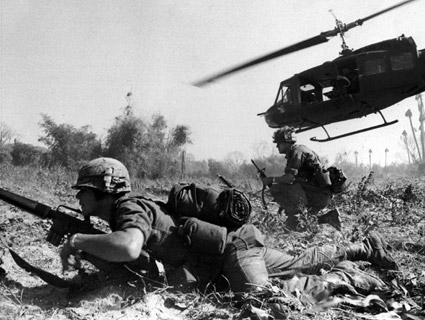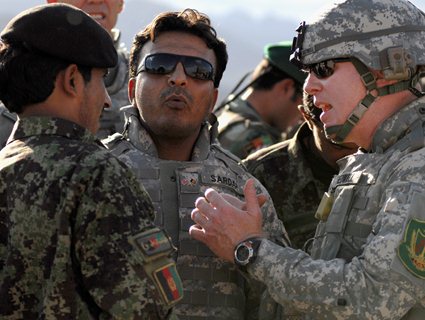
US soldiers on a search and destroy mission in Vietnam.<a href="http://en.wikipedia.org/wiki/File:Bruce_Crandall%27s_UH-1D.jpg">Wikimedia Commons</a>
This story first appeared on the TomDispatch website.
Take off your hat. Taps is playing. Almost four decades late, the Vietnam War and its post-war spawn, the Vietnam Syndrome, are finally heading for their American grave. It may qualify as the longest attempted burial in history. Last words—both eulogies and curses— have been offered too many times to mention, and yet no American administration found the silver bullet that would put that war away for keeps.
![]() Richard Nixon tried to get rid of it while it was still going on by “Vietnamizing” it. Seven years after it ended, Ronald Reagan tried to praise it into the dustbin of history, hailing it as “a noble cause.” Instead, it morphed from a defeat in the imperium into a “syndrome,” an unhealthy aversion to war-making believed to afflict the American people to their core.
Richard Nixon tried to get rid of it while it was still going on by “Vietnamizing” it. Seven years after it ended, Ronald Reagan tried to praise it into the dustbin of history, hailing it as “a noble cause.” Instead, it morphed from a defeat in the imperium into a “syndrome,” an unhealthy aversion to war-making believed to afflict the American people to their core.
A decade later, after the US military smashed Saddam Hussein’s army in Kuwait in the First Gulf War, George H.W. Bush exulted that the country had finally “kicked the Vietnam Syndrome once and for all.” As it turned out, despite the organization of massive “victory parades” at home to prove that this hadn’t been Vietnam redux, that war kicked back. Another decade passed and there were H.W.’s son W. and his advisors planning the invasion of Iraq through a haze of Vietnam-constrained obsessions.
W.’s top officials and the Pentagon would actually organize the public relations aspect of that invasion and the occupation that followed as a Vietnam opposite’s game—no “body counts” to turn off the public, plenty of embedded reporters so that journalists couldn’t roam free and (as in Vietnam) harm the war effort, and so on. The one thing they weren’t going to do was lose another war the way Vietnam had been lost. Yet they managed once again to bog the US military down in disaster on the Eurasian mainland, could barely manage to win a heart or a mind, and even began issuing body counts of the enemy dead.
“We don’t do body counts,” General Tommy Franks, Afghan War commander, had insisted in 2001, and as late as November 2006, the president was still expressing his irritation about Iraq to a group of conservative news columnists this way: “We don’t get to say that—a thousand of the enemy killed or whatever the number was. It’s happening. You just don’t know it.” The problem, he explained, was: “We have made a conscious effort not to be a body count team” (à la Vietnam). And then, of course, those body counts began appearing.
Somehow, over the endless years, no matter what any American president tried, The War—that war—and its doppelganger of a syndrome, a symbol of defeat so deep and puzzling Americans could never bear to fully take it in, refused to depart town. They were the ghosts on the battlements of American life, representing—despite the application of firepower of a historic nature—a defeat by a small Asian peasant land so unexpected that it simply couldn’t be shaken, nor its “lessons” learned.
National Security Advisor Henry Kissinger was typical at the time in dismissing North Vietnam in disgust as “a little fourth rate power,” just as Chairman of the Joint Chiefs Admiral Thomas Moorer would term it “a third-rate country with a population of less than two counties in one of the 50 states of the United States.” All of which made its victory, in some sense, beyond comprehension.
A Titleholder for Pure, Long-Term Futility
That was then. This is now and, though the frustration must seem familiar, Washington has gotten itself into a situation on the Eurasian mainland so vexing and perplexing that Vietnam has finally been left in the dust. In fact, if you hadn’t noticed—and weirdly enough no one has—that former war finally seems to have all but vanished.
If you care to pick a moment when it first headed for the exits, when we all should have registered something new in American consciousness, it would undoubtedly have been mid-2010 when the media decided that the Afghan War, then 8½ years old, had superseded Vietnam as “the longest war” in US history. Today, that claim has become commonplace, even though it remains historically dubious (which may be why it’s significant).
Afghanistan is, in fact, only longer than Vietnam if you decide to date the start of the American war there to 1964, when Congress passed the Tonkin Gulf Resolution (in place of an actual declaration of war), or 1965, when American “combat troops” first arrived in South Vietnam. By then, however, there were already 16,000 armed American “advisors” there, Green Berets fighting there, American helicopters flying there. It would be far more reasonable to date America’s war in Vietnam to 1961, the year of its first official battlefield casualty and the moment when the Kennedy administration sent in 3,000 military advisors to join the 900 already there from the Eisenhower years. (The date of the first American death on the Vietnam Wall, however, is 1956, and the first American military man to die in Vietnam—an American lieutenant colonel mistaken by Vietnamese guerrillas for a French officer—was killed in Saigon in 1945.)
Of course, massive US support for the French version of the Vietnam War in the early 1950s could drive that date back further. Similarly, if you wanted to add in America’s first Afghan War, the CIA-financed anti-Soviet war of the mujahideen from 1980 to 1989, you might once again have a “longest war” competition.
The essential problem in dating wars these days is that we no longer declare them, so they just tend to creep up on us. In addition, because undeclared war has melded into something like permanent war on the American scene, we might well be setting records every day on the Eurasian mainland—if, for instance, you care to include the First Gulf War and the continued military actions against Saddam Hussein’s Iraq which, after 2001, blended into the Bush administration’s Global War on Terror, its invasion of Afghanistan, and then, of course, Iraq (again).
 For those who want a definitive “longest,” however, the latest news is promising. Obama administration negotiations with Afghan President Hamid Karzai’s government are reportedly close to complete. The two sides are expected to arrive at a “strategic partnership” agreement leaving US forces (trainers, advisors, special operations troops, and undoubtedly scads of private contractors) ensconced on bases in Afghanistan well beyond 2014. If such official desire becomes reality, then the Vietnam record might indeed be at an end.
For those who want a definitive “longest,” however, the latest news is promising. Obama administration negotiations with Afghan President Hamid Karzai’s government are reportedly close to complete. The two sides are expected to arrive at a “strategic partnership” agreement leaving US forces (trainers, advisors, special operations troops, and undoubtedly scads of private contractors) ensconced on bases in Afghanistan well beyond 2014. If such official desire becomes reality, then the Vietnam record might indeed be at an end.
What’s important, however, isn’t which war holds the record, but that media urge in 2010 to anoint Afghanistan the titleholder for pure long-term futility. In retrospect, that represented a changing-of-the-guard moment.
Now, skip ahead almost two years and consider what’s missing in action today. After all, dealing with the Afghan War in Vietnam-analogy terms right now would be like lining up ducks at a shooting gallery. Just take a run through the essential Vietnam War checklist: there’s “quagmire” (check!); dropping the idea of winning “hearts and minds” (check!); the fact that we’ve entered the “Afghanization” phase of the war, with endless rosy prognostications about, followed by grim reports on, the training of the Afghan army to replace US combat troops (check!).
There are those sagging public opinion polls about the war, dropping steadily into late-Vietnam territory (check!); the continued insistence of American military officials that “progress” is being made in the face of disaster and disintegration (not quite “light at the end of the tunnel” territory, but nonetheless a check! for sure).
There are those bomb-able, or in our era drone-able, “sanctuaries” across the border (check!); American massacre stories, most recently a one-man version of My Lai (check!); a prickly leader who irritates his American counterparts and is seen as an obstacle to success (check!), and so on—and on and on.
While the Afghan War has always had its many non-Vietnam aspects—geographical, historical, geopolitical, and in terms of casualties—anyone could have had a Vietnam field day with the present situation. At almost any previous moment in the last decades, many undoubtedly would have, and yet what’s striking is that this time around no one has. Unlike any administration since the Nixon years, nobody in Obama’s crowd now seems to have Vietnam obsessively on the brain.
What was taken as the last significant reference to the war from a major official came from Bush holdover Secretary of Defense Robert Gates. In February 2011, four months before he left the Pentagon, Gates gave a “farewell” address at West Point in which he told the cadets, “[I]n my opinion, any future defense secretary who advises the president to again send a big American land army into Asia or into the Middle East or Africa should ‘have his head examined,’ as General MacArthur so delicately put it.” This, press reports incorrectly claimed, was that general’s Vietnam advice for President Kennedy in 1961. (The statement Gates quoted, however, was made in 1950 after the North Koreans invaded South Korea.)
A Vietnam Analogy Memorial
Since then, Washington generally seems to have dropped Vietnam through the memory hole. Well-connected pundits seldom mention its example any more. Critics have generally stopped using it to anathematize the ongoing war in Afghanistan. In a wasteland of growing disasters, that war now seems to have gained full recognition as a quagmire in its own right. No help needed.
And yet I did find one recent exception to the general rule. Let me offer it here as my own memorial to the Vietnam analogy. Recently in a news briefing, US war commander in Afghanistan General John Allen tried to offer context for a phenomenon that seems close to unique in modern history. (You might have to go back to the Sepoy Rebellion in British India of the nineteenth century to find its like.) Afghan “allies” in police or army uniforms have been continually blasting away American and NATO soldiers they live and work with—something now common enough to have its own military term: “green on blue” violence. In doing so, Allen made a passing comment that might be thought of as the last Vietnam War analogy of our era. “I think it is a characteristic of counterinsurgencies that we’ve experienced before,” he said. “We experienced these in Iraq. We experienced them in Vietnam… It is a characteristic of this kind of warfare.”
How appropriate that, almost 40 years later, the general, who was still attending the US Naval Academy when Vietnam ended, evidently remembers that war about as accurately as he might recall the War of 1812. In fact, Vietnamese allies did not regularly, or even rarely, turn their guns on their American allies. In the far more “fratricidal” acts of that era, what might then have been termed “khaki on khaki” violence, the “Afghans” of the moment were American troops who reasonably regularly committed acts of violence—called “fragging” for the fragmentation grenades of the period—against their own officers. (“Word of the deaths of officers will bring cheers at troop movies or in bivouacs of certain units,” wrote Marine historian Col. Robert Heinl, Jr., in 1971. “In one such division… fraggings during 1971 have been authoritatively estimated to be running about one a week.”)
Still, credit must be given. Increasingly poorly remembered, Vietnam is now one for the ages. After so many years, Afghanistan has finally emerged as a quagmire beholden to no other war. What an achievement! Our moment, Afghanistan included, has proven so extreme, so disastrous, that it’s finally put the unquiet ghost of Vietnam in its grave. And here’s the miracle: it has all happened without anyone in Washington grasping the essence of that now-ancient defeat, or understanding a thing.
The “lessons of Vietnam,” fruitlessly discussed for five decades, taught Washington so little that it remains trapped in a hopeless war on the Eurasian mainland, continues to pursue a military-first policy globally that might even surprise American leaders of the Vietnam era, has turned the planet into a “free fire zone,” and considers military power its major asset, a first not a last resort, and the Pentagon the appropriate place to burn its national treasure.
After Vietnam, the US at least took a few years to lick its wounds. Now, it just ramps up the latest military flavor of the month—at the moment, special operations forces and drones—elsewhere.
Call it not the fog, but the smog of war.
And in case you haven’t noticed, the vans are already on the block. The Afghan Syndrome is moving into the neighborhood and the welcome wagons are out.
Tom Engelhardt, co-founder of the American Empire Project and the author of The American Way of War: How Bush’s Wars Became Obama’s as well as The End of Victory Culture, runs the Nation Institute’s TomDispatch.com. His latest book, The United States of Fear (Haymarket Books), has just been published. Click here to catch Timothy MacBain’s latest Tomcast audio interview in which Engelhardt reflects on one theme from his new book, the unnatural growth of the US national security state, or click here to watch him discuss another, the way post-Cold-War Washington chose “the Soviet Path,” at the Nation magazine’s website. Follow TomDispatch on Twitter @TomDispatch and join us on Facebook. To stay on top of important articles like these, sign up to receive the latest updates from TomDispatch.com here.







